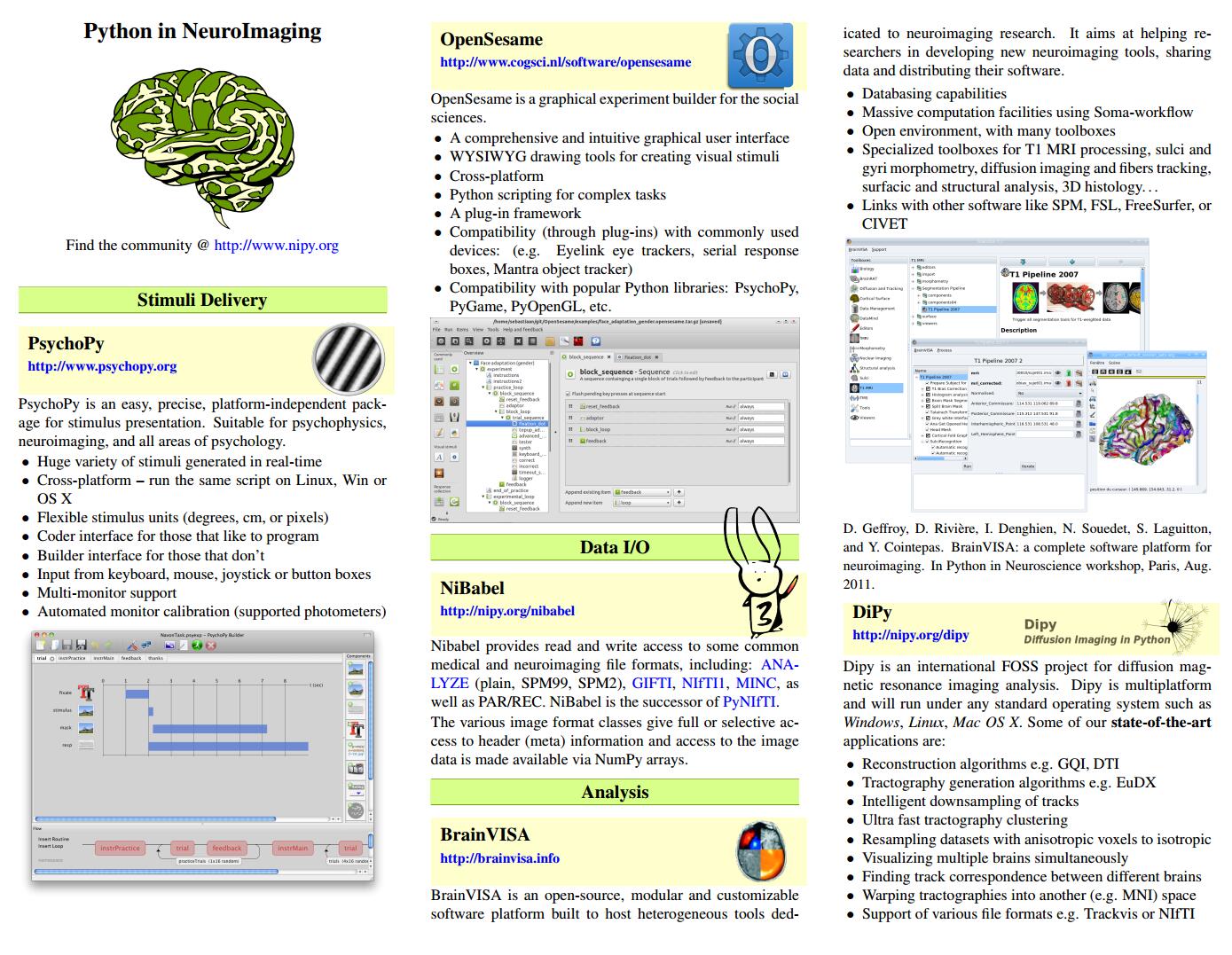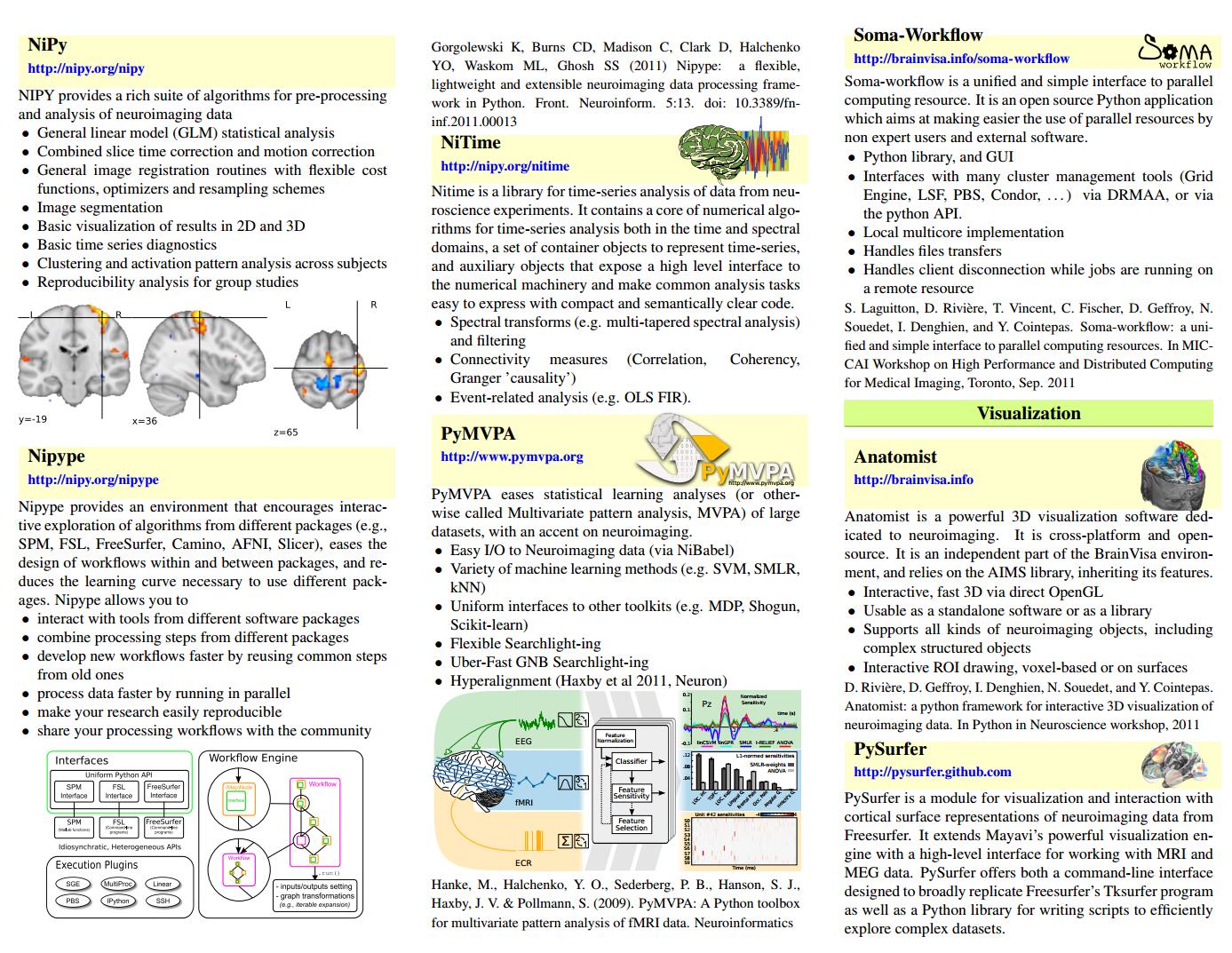Python in neuroimaging


Python in NeuroImaging
Find the community @ http://www.nipy.org
Stimuli Delivery
PsychoPy
http://www.psychopy.org
PsychoPy is an easy, precise,
platform-independent package for stimulus presentation. Suitable for
psychophysics, neuroimaging, and all areas of psychology.
∙ Huge variety of
stimuli generated in real-time
∙ Cross-platform –
run the same script on Linux, Win or OS X
∙ Flexible stimulus
units (degrees, cm, or pixels)
∙ Coder interface for
those that like to program
∙ Builder interface
for those that don’t
∙ Input from
keyboard, mouse, joystick or button boxes
∙ Multi-monitor
support
∙ Automated monitor
calibration (supported photometers)
OpenSesame
http://www.cogsci.nl/software/opensesame
OpenSesame is a graphical
experiment builder for the social sciences.
∙ A comprehensive and
intuitive graphical user interface
∙ WYSIWYG drawing
tools for creating visual stimuli
∙ Cross-platform
∙ Python scripting
for complex tasks
∙ A plug-in framework
∙ Compatibility
(through plug-ins) with commonly used devices: (e.g. Eyelink eye trackers,
serial response boxes, Mantra object tracker)
∙ Compatibility with
popular Python libraries: PsychoPy, PyGame,
PyOpenGL, etc.
Data I/O
NiBabel
http://nipy.org/nibabel
Nibabel provides read and
write access to some common medical and neuroimaging file formats,
including: ANALYZE (plain, SPM99, SPM2), GIFTI, NIfTI1, MINC,
as well as PAR/REC. NiBabel is the successor of PyNIfTI.
The various image format classes give full or selective
access to header (meta) information and access to the image data is made
available via NumPy arrays.
Analysis
BrainVISA
http://brainvisa.info
BrainVISA is an open-source,
modular and customizable software
platform built to host heterogeneous tools dedicated to neuroimaging research.
It aims at helping researchers in developing new neuroimaging tools, sharing
data and distributing their software.
∙ Databasing
capabilities
∙ Massive computation
facilities using Soma-workflow
∙ Open environment,
with many toolboxes
∙ Specialized
toolboxes for T1 MRI processing, sulci and gyri
morphometry, diffusion imaging and fibers tracking, surfacic and structural analysis, 3D histology. . .
∙ Links with other
software like SPM, FSL, FreeSurfer, or CIVET
D.
Geffroy, D. Rivière, I. Denghien, N. Souedet, S. Laguitton, and Y. Cointepas. BrainVISA: a complete
software platform for neuroimaging. In Python in
Neuroscience workshop, Paris, Aug. 2011.
DiPy
http://nipy.org/dipy
Dipy is an international FOSS
project for diffusion magnetic resonance imaging analysis. Dipy is
multiplatform and will run under
any standard operating system such as Windows, Linux, Mac OS X. Some of our state-of-the-artapplications are:
∙ Reconstruction
algorithms e.g. GQI, DTI
∙ Tractography
generation algorithms e.g. EuDX
∙ Intelligent
downsampling of tracks
∙ Ultra fast
tractography clustering
∙ Resampling datasets
with anisotropic voxels to isotropic
∙ Visualizing
multiple brains simultaneously
∙ Finding track
correspondence between different brains
∙ Warping
tractographies into another (e.g. MNI) space
∙ Support of various
file formats e.g. Trackvis or NIfTI
NiPy
http://nipy.org/nipy
NIPY provides a rich suite of
algorithms for pre-processing and analysis of neuroimaging data
∙ General linear
model (GLM) statistical analysis
∙ Combined slice time
correction and motion correction
∙ General image
registration routines with flexible cost functions,
optimizers and resampling schemes
∙ Image segmentation
∙ Basic visualization
of results in 2D and 3D
∙ Basic time series
diagnostics
∙ Clustering and
activation pattern analysis across subjects
∙ Reproducibility
analysis for group studies
Nipype
http://nipy.org/nipype
Nipype provides an environment
that encourages interactive exploration of algorithms from different packages
(e.g., SPM, FSL, FreeSurfer, Camino, AFNI,
Slicer),
eases the design of workflows within and
between packages, and reduces the learning curve necessary to use different
packages. Nipype allows you to
∙ interact with tools
from different software packages
∙ combine processing
steps from different packages
∙ develop new
workflows faster by reusing common steps from old
ones
∙ process data faster
by running in parallel
∙ make your research
easily reproducible
∙ share your
processing workflows with the community
Gorgolewski
K, Burns CD, Madison C, Clark D, Halchenko YO, Waskom ML, Ghosh SS (2011) Nipype: a flexible, lightweight and extensible neuroimaging data processing
framework in Python. Front. Neuroinform. 5:13. doi: 10.3389/fninf.2011.00013
NiTime
http://nipy.org/nitime
Nitime is a library for
time-series analysis of data from neuroscience experiments. It contains a core
of numerical algorithms for time-series analysis both in the time and spectral domains,a set of container objects to
represent time-series, and auxiliary objects that
expose a high level interface to the numerical
machinery and make common analysis tasks easy to
express with compact and semantically clear code.
∙ Spectral transforms
(e.g. multi-tapered spectral analysis) and
filtering
∙ Connectivity
measures (Correlation, Coherency, Granger
’causality’)
∙ Event-related
analysis (e.g. OLS FIR).
PyMVPA
http://www.pymvpa.org
PyMVPA
eases statistical learning analyses (or otherwise called Multivariate pattern
analysis, MVPA) of large datasets, with an accent on neuroimaging.
∙ Easy I/O to Neuroimaging data (via NiBabel)
∙ Variety of machine learning methods (e.g. SVM, SMLR, kNN)
∙ Uniform interfaces to other toolkits (e.g. MDP, Shogun, Scikit-learn)
∙ Flexible Searchlight-ing
∙ Uber-Fast GNB Searchlight-ing
∙ Hyperalignment (Haxby et al 2011, Neuron)
Hanke,
M., Halchenko, Y. O., Sederberg, P. B., Hanson, S. J., Haxby, J. V. & Pollmann, S. (2009).
PyMVPA: A Python toolbox for multivariate pattern
analysis of fMRI data. Neuroinformatics
Hanke, M., Halchenko, Y. O., Sederberg, P.
B., Hanson, S. J., Haxby, J. V. & Pollmann, S. (2009). PyMVPA: A Python
toolbox for multivariate pattern analysis of fMRI data. Neuroinformatics
Soma-Workflow
http://brainvisa.info/soma-workflow
Soma-workflow is a unified and
simple interface to parallel computing resource. It is an open source Python application
which aims at making easier the use of parallel
resources by non expert users and external
software.
∙ Python library, and
GUI
∙ Interfaces with
many cluster management tools (Grid Engine, LSF,
PBS, Condor, . . . ) via DRMAA, or via the python
API.
∙ Local multicore
implementation
∙ Handles files
transfers
∙ Handles client
disconnection while jobs are running on a remote
resource S.
Laguitton, D. Rivière, T. Vincent, C. Fischer, D. Geffroy, N. Souedet, I. Denghien, and Y. Cointepas.
Soma-workflow: a unified and simple interface to parallel computing resources.
In MICCAI Workshop on High Performance and Distributed Computing for Medical Imaging, Toronto, Sep. 2011
Visualization
Anatomist
http://brainvisa.info
Anatomist is a powerful 3D
visualization software dedicated to neuroimaging. It is cross-platform and
opensource. It is an independent part of the BrainVisa environment, and relies
on the AIMS library, inheriting its features.
∙ Interactive, fast
3D via direct OpenGL
∙ Usable as a
standalone software or as a library
∙ Supports all kinds
of neuroimaging objects, including complex
structured objects
∙ Interactive ROI
drawing, voxel-based or on surfaces D. Rivière, D. Geffroy, I. Denghien, N. Souedet, and Y. Cointepas. Anatomist: a python framework for
interactive 3D visualization of neuroimaging
data. In Python in Neuroscience workshop, 2011
PySurfer
http://pysurfer.github.com
PySurfer is a module for
visualization and interaction with cortical surface representations of neuroimaging data from
Freesurfer. It extends Mayavi’s powerful visualization
engine with a high-level interface for working with MRI and MEG data. PySurfer offers both a command-line interface
designed to broadly replicate Freesurfer’s Tksurfer
program as well as a Python library for writing
scripts to efficiently explore complex datasets.

